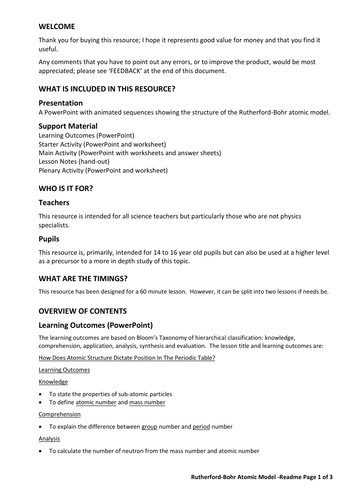












The main presentation is a PowerPoint with animated sequences showing the structure of the Rutherford-Bohr atomic model
Support Material
Readme (instructions for whole lesson)
Learning Outcomes (PowerPoint)
Starter Activity (PowerPoint and Worksheet)
Main Activity (PowerPoint with worksheets and answer sheets)
Lesson Notes (hand-out)
Plenary Activity (PowerPoint and worksheet)
It is intended for all science teachers but particularly those who are not physics specialists. It is, primarily, aimed at 14 to 16 year old pupils but can also be used at a higher level as a precursor to a more in-depth study of this topic. Normally, the activities would fill a 60 minute lesson but could be spread over two lessons if needs be.
If you buy this resource, please print the Readme document as it contains the instructions and details of the files included.
Learning Outcomes
The learning outcomes are based on Bloom’s taxonomy of hierarchical classification: knowledge, comprehension, application, analysis, synthesis and evaluation. The lesson title and learning outcomes are:
How Does Atomic Number Dictate Position In The Periodic Table?
Learning Outcomes
Knowledge
- to state the properties of sub-atomic particles
- to define atomic number and mass number
Comprehension - to state the difference between group number and period number
Analysis - to calculate the number of neutrons from the mass number and atomic number
Differentiation
The activities have varying degrees of differentiation; please refer to the Readme document.
Something went wrong, please try again later.
This resource hasn't been reviewed yet
To ensure quality for our reviews, only customers who have purchased this resource can review it
Report this resourceto let us know if it violates our terms and conditions.
Our customer service team will review your report and will be in touch.